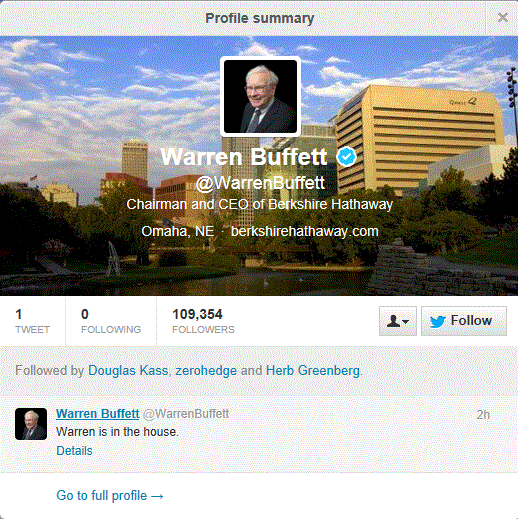The long-awaited S-1 filing from Twitter Inc. has now been filed with the Securities and Exchange Commission. No formal terms have been set, but the company is filing to sell up to $1 billion worth of its common stock. We have seen now that the stock ticker is being proposed as TWTR, but it does not yet specify whether this will be listed on the New York Stock Exchange or on the Nasdaq. Source: Twitter
Source: Twitter
Twitter’s IPO syndicate is rather large. It includes Goldman Sachs, Morgan Stanley, J.P. Morgan, Bank of America Merrill Lynch, Deutsche Bank Securities, Allen & Company and a firm called CODE Advisors. Here are some bragging terms: Twitter claims more than 200 million active monthly users. It also claims more than 500 million tweets per day.
Do we need to tell you what Twitter does? No. Its tweets are limited to 140 characters and the formal numbers are as follows: more than 215 million monthly active users, over 100 million daily active users, with the total users creating approximately 500 million tweets each day.
Twitter’s filing says:
Tweets have appeared on over one million third-party websites, and in the second quarter of 2013 there were approximately 30 billion online impressions of Tweets off of our properties.
This comment should stand out handily:
Mobile has become the primary driver of our business. … In the three months ended June 30, 2013, 75% of our average monthly average users accessed Twitter from a mobile device … and over 65% of our advertising revenue was generated from mobile devices. We expect that the proportion of active users on, and advertising revenue generated from, mobile devices, will continue to grow in the near term.
From 2011 to 2012, revenue increased by 198% to $316.9 million, and the net loss decreased by 38% to $79.4 million. Adjusted EBITDA in that time rose 149% to $21.2 million. From the first six months of 2012 to the first six months of 2013, revenue increased by some 107% to $253.6 million. Unfortunately, its net loss increased by 41% to $69.3 million, even though the adjusted EBITDA rose by $20.7 million to $21.4 million.
We want you to look closely under the “Risks Associated with Our Business” and see that there is one risk that is not brought up until later. What happens when the media and Google turn on Twitter for effectively being one more demonetization tool for their content (which actually pays their bills)? The RISK FACTORS does say:
We compete against many companies to attract and engage users, including companies which have greater financial resources and substantially larger user bases, such as Facebook (including Instagram), Google, LinkedIn, Microsoft and Yahoo!, which offer a variety of Internet and mobile device-based products, services and content. For example, Facebook operates a social networking site with significantly more users than Twitter and has been introducing features similar to those of Twitter. In addition, Google may use its strong position in one or more markets to gain a competitive advantage over us in areas in which we operate, including by integrating competing features into products or services they control. As a result, our competitors may acquire and engage users at the expense of the growth or engagement of our user base, which would negatively affect our business. We also compete against smaller companies, such as Sina Weibo, LINE and Kakao, each of which is based in Asia.
Individual ownership is listed as Evan Williams at 12%, Peter Fenton at 6.7%, Jack Dorsey at 4.9% and Richard Costolo at 1.6%. Then the 5% stockholders from venture groups are listed as entities affiliated with groups as follows: Rizvi Traverse, Spark Capital, Benchmark Capital Partners, Union Square Ventures and also DST Global.
The filing also said:
Assuming the conversion of all outstanding shares of our Class A junior preferred stock and our convertible preferred stock into shares of our common stock, which will occur immediately prior to the completion of this offering, as of June 30, 2013, there were 472,613,753 shares of our common stock outstanding, held by 704 stockholders of record, and no shares of our preferred stock outstanding.
Since our inception, we have incurred significant operating losses, and, as of June 30, 2013, we had an accumulated deficit of $418.6 million.
SEE ALSO: TWITTER’S FULL S-1 FILING
We noted earlier (4:14 p.m. EST):
Word has been out that Twitter will file its S-1 with the Securities and Exchange Commission before the end of the week. We are now expecting this A-1 filing to drop as soon as late in the afternoon on Thursday.
See page 2 for a full summary of additional risk factors.
The RISK FACTORS goes on and on but here are some of the bullet points:
- Since our inception, we have incurred significant operating losses, and, as of June 30, 2013, we had an accumulated deficit of $418.6 million.
- We compete against many companies to attract and engage users, including companies which have greater financial resources and substantially larger user bases, such as Facebook (including Instagram), Google, LinkedIn, Microsoft and Yahoo!,
- If we fail to grow our user base, or if user engagement or ad engagement on our platform decline, our revenue, business and operating results may be harmed.
- If our users do not continue to contribute content or their contributions are not valuable to other users, we may experience a decline in the number of users accessing our products and services and user engagement, which could result in the loss of advertisers and revenue.
- We generate the substantial majority of our revenue from advertising. The loss of advertising revenue could harm our business.
- If we are unable to compete effectively for users and advertiser spend, our business and operating results could be harmed.
- Our operating results may fluctuate from quarter to quarter, which makes them difficult to predict.
- User growth and engagement depend upon effective interoperation with operating systems, networks, devices, web browsers and standards that we do not control.
- If we fail to expand effectively in international markets, our revenue and our business will be harmed.
- We have a limited operating history in a new and unproven market for our platform, which makes it difficult to evaluate our future prospects and may increase the risk that we will not be successful.
- Our business depends on continued and unimpeded access to our products and services on the Internet by our users and advertisers. If we or our users experience disruptions in Internet service or if Internet service providers are able to block, degrade or charge for access to our products and services, we could incur additional expenses and the loss of users and advertisers.
- Our new products, services and initiatives and changes to existing products, services and initiatives could fail to attract users and advertisers or generate revenue.
- Spam could diminish the user experience on our platform, which could damage our reputation and deter our current and potential users from using our products and services.
- If we fail to effectively manage our growth, our business and operating results could be harmed.
- Our business and operating results may be harmed by a disruption in our service, or by our failure to timely and effectively scale and adapt our existing technology and infrastructure.
- Action by governments to restrict access to our products and services or censor Twitter content could harm our business and operating results.
- If we are unable to maintain and promote our brand, our business and operating results may be harmed.
- Negative publicity could adversely affect our business and operating results.
- Our future performance depends in part on support from platform partners and data partners.
- We focus on product innovation and user engagement rather than short-term operating results.
- Our international operations are subject to increased challenges and risks.
- Our products and services may contain undetected software errors, which could harm our business and operating results.
- Our business is subject to complex and evolving U.S. and foreign laws and regulations. These laws and regulations are subject to change and uncertain interpretation, and could result in claims, changes to our business practices, monetary penalties, increased cost of operations or declines in user growth, user engagement or ad engagement, or otherwise harm our business.
- Regulatory investigations and settlements could cause us to incur additional expenses or change our business practices in a manner materially adverse to our business.
- Even though Twitter is a global platform for public self-expression and conversation, user trust regarding privacy is important to the growth of users and the increase in user engagement on our platform, and privacy concerns relating to our products and services could damage our reputation and deter current and potential users and advertisers from using Twitter.
- If our security measures are breached, or if our products and services are subject to attacks that degrade or deny the ability of users to access our products and services, our products and services may be perceived as not being secure, users and advertisers may curtail or stop using our products and services and our business and operating results could be harmed…. For example, in February 2013, we disclosed that sophisticated unknown third parties had attacked our systems and may have had access to limited information for approximately 250,000 users.
- We may face lawsuits or incur liability as a result of content published or made available through our products and services.
- Our intellectual property rights are valuable, and any inability to protect them could reduce the value of our products, services and brand.
- We are currently, and expect to be in the future, party to intellectual property rights claims that are expensive and time consuming to defend, and, if resolved adversely, could have a significant impact on our business, financial condition or operating results… We presently are involved in a number of intellectual property lawsuits, and as we face increasing competition and gain an increasingly high profile, we expect the number of patent and other intellectual property claims against us to grow.
- Many of our products and services contain open source software, and we license some of our software through open source projects, which may pose particular risks to our proprietary software, products, and services in a manner that could have a negative effect on our business.
- We may expend substantial funds in connection with the tax liabilities that arise upon the initial settlement of RSUs in connection with this offering, and the manner in which we fund that expenditure may have an adverse effect on our financial condition.
- We may require additional capital to support our operations or the growth of our business, and we cannot be certain that this capital will be available on reasonable terms when required, or at all.
- We rely on assumptions and estimates to calculate certain of our key metrics, and real or perceived inaccuracies in such metrics may harm our reputation and negatively affect our business.
- We depend on highly skilled personnel to grow and operate our business, and if we are unable to hire, retain and motivate our personnel, we may not be able to grow effectively.
- Our corporate culture has contributed to our success, and if we cannot maintain this culture as we grow, we could lose the innovation, creativity and teamwork fostered by our culture, and our business may be harmed.
- We rely in part on application marketplaces and Internet search engines to drive traffic to our products and services, and if we fail to appear high up in the search results or rankings, traffic to our platform could decline and our business and operating results could be adversely affected.
- More people are using devices other than personal computers to access the Internet and new platforms to produce and consume content, and we need to continue to promote the adoption of our mobile applications, and our business and operating results may be harmed if we are unable to do so.
- Future acquisitions and investments could disrupt our business and harm our financial condition and operating results.
- If we fail to maintain an effective system of disclosure controls and internal control over financial reporting, our ability to produce timely and accurate financial statements or comply with applicable regulations could be impaired.
- We are an emerging growth company, and any decision on our part to comply only with certain reduced reporting and disclosure requirements applicable to emerging growth companies could make our common stock less attractive to investors.
- Our business is subject to the risks of earthquakes, fire, power outages, floods and other catastrophic events, and to interruption by man-made problems such as terrorism.
- We may have exposure to greater than anticipated tax liabilities, which could adversely impact our operating results.
- If our goodwill or intangible assets become impaired, we may be required to record a significant charge to earnings.
- Our ability to use our net operating loss carryforwards and certain other tax attributes may be limited.
- The market price of our common stock may be volatile, and you could lose all or part of your investment.
Essential Tips for Investing: Sponsored
A financial advisor can help you understand the advantages and disadvantages of investment properties. Finding a qualified financial advisor doesn’t have to be hard. SmartAsset’s free tool matches you with up to three financial advisors who serve your area, and you can interview your advisor matches at no cost to decide which one is right for you. If you’re ready to find an advisor who can help you achieve your financial goals, get started now.
Investing in real estate can diversify your portfolio. But expanding your horizons may add additional costs. If you’re an investor looking to minimize expenses, consider checking out online brokerages. They often offer low investment fees, helping you maximize your profit.
Thank you for reading! Have some feedback for us?
Contact the 24/7 Wall St. editorial team.



